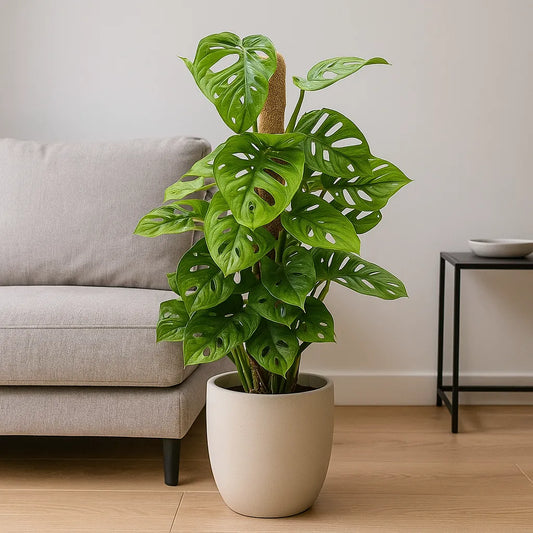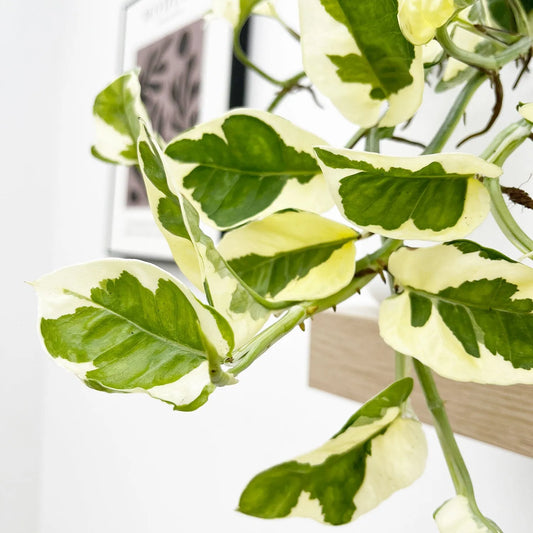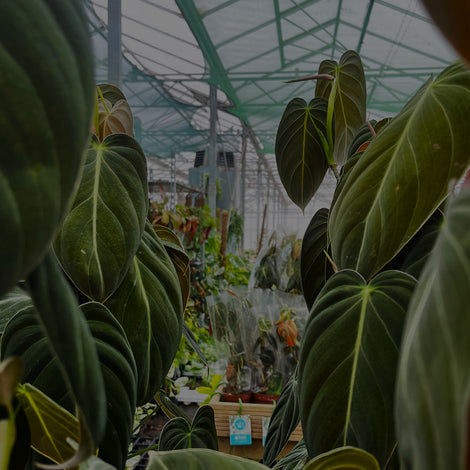Why is my Alocasia Zebrina drooping?
The Alocasia is a tropical houseplant that is prized for its bold and beautiful leaves. This species comes in a variety of colours and sizes, but each one is beautiful and a great feature in the home.
However, it can be a fussy plant that likes certain conditions but, unlike some species, it is good at telling you what is wrong with it. One of the best ways to diagnose problems with your plant is to take a close look at the leaves. In this guide we will take you through what to look out for in the leaves of your Alocasia Zebrina plant, what they mean and how to rectify the problem.
Overwatering
Like most tropical plants the Alocasia Zebrina actually prefers to be underwatered rather than overwatered. Prolonged overwatering can lead to the suffocating of the roots and an increased chance of disease.
What to look out for:
Soggy soil - First, check the soil. If it is soggy for more than a few days after watering it is very likely that your plant is overwatered.
Yellowing leaves - This will often start with the lower leaves and slowly spread up the foliage. This is nearly always a sign that there is too much water being stored in the plant's stem.
Blisters on leaves - An overwatered Alocasia that is holding too much water in its cells will begin to blister. When touched these blisters will feel watery and may pop. When these blisters appear the leaf will begin to droop a few days to a week later.
Bacterial spots - Too much water in the soil makes the plant more susceptible to bacterial diseases. Many of these diseases will appear on your plant as wet, brown spots that slowly grow to cover your Alocasia before the leaves begin to droop and rot.
Rotting smell - If your plant is left in water for too long they will develop root rot. This is caused by the roots of the alocasia being suffocated. You can tell if your Alocasia has root rot if there is a faint rotting smell near the base of the plant. This smell will get stronger as time goes on, and you should act quickly if you smell it as root rot can be fatal to your Alocasia.
What can cause overwatering and how to fix it
Poorly draining soil - A poorly draining soil will increase the chances that your Alocasia will be overwatered or will be sat in soggy soil for too long. To rectify this first, make sure there are drainage holes in the bottom of your pot.
Secondly you will need to make sure that your soil is well-draining. To do this, check that the water is filtering all that way through the pot and that there is no moisture sitting on the top layer of soil. Another sign of overwatered soil is moss or mould growing in the pot.
Over potting - If your Alocasia is in a pot that is too big for it, the soil will take much longer to drain, increasing the risk of overwatering. Make sure you choose a pot that is only slightly larger than the roots, and never increase the size of your pot by more than two inches.
Time of year - Alocasia plants will go dormant in the winter and will grow much more slowly. When in this state they will almost stop absorbing water. The main way to avoid overwatering your plant when it's dormant is to reduce how often you water your plant. To make sure you are watering the plant correctly, regularly check the soil and water only when it is completely dry and you see the leaves start to droop slightly.
Lighting - The speed that an Alocasia grows is determined by how much sunlight it gets, and how fast its growing will affect how much water it needs. An Alocasia that is kept in the shade will require less water than one near a sunny windowsill. If your Alocasia leaves are drooping try to move it to a sunnier spot.
Low Humidity
Alocasia are tropical plants that grow in naturally humid environments. They have adapted to these conditions and need to be kept humid to to stay at their best. Low humidity will cause some issues in the appearance of the plant.
What to look out for:
Leaf curling - An Alocasia leaf that receives no humid air will begin to curl up from the edges. This is the first sign of trouble and is caused by a lack of structure as the leaf starts to dry out.
Dry leaves - The leaves of a non humidified plant will quickly dry out and become papery. Not only will this cause them to wilt and droop, but they will also become very brittle. This is because an Alocasia stores most of its water in it’s stem and not its leaves. This means that the leaves will dry a lot quicker than the rest of the plant.
Brown leaves - This is usually the last stage of a leaf that has low humidity. At this stage the leaf is almost dead and will need quick action to help reverse the damage
How to fix an Alocasia with low humidity
Move your Alocasia to a more humid space - The easiest way to keep your plant humid is to keep it in a naturally humid space. The Alocasia is an ideal plant for a bathroom or kitchen.
Spray the leaves regularly - If your plant is not in a naturally humid space then your easiest option is to regularly spray the leaves. This will keep them well moisturised and stop any dust building up on them, keeping them looking neat.
Use a pebble tray - A good way to keep your plant humid is to place it on a pebble tray. These help to make all the air around the plant more humid and can be more effective than spraying the plant directly. You can also buy an electric humidifier or a group humidity tray if you have more plants in one space.
Buy a hygrometer - A hygrometer is a device that measures the humidity around your plant. An alocasia thrives best if you maintain a humidity of around 40%.
Low Light
Lighting is the main factor that will determine the health of your Alocasia. This is a plant that likes bright, but indirect light and if put in conditions that are too shaded for it the leaves will begin to fade and droop.
What to look for:
Slow Growth - The speed that an alocasia grows will depend on how much light it gets. If your plant is not receiving enough light the first thing you will notice is that it is growing slowly. This will also have a knock on effect to how much water it is absorbing and may lead to it being overwatered
Pale leaves - A sign that your alocasia is not getting enough light is that the leaves are starting to go pale. This is caused by the leaf not receiving enough light to produce enough nutrients to support the leaves.
Wet soil - An Alocasia that doesn’t receive enough light will grow a lot slower than other plants. A slower growing alocasia will absorb less water, so you will end up with a plant pot that is wet to the touch. Wet soil will eventually lead to root rot and the death of your plant.
How to fix an Alocasia with low light
Move the plant to a sunnier spot - This is the easiest way to sort out issues around an Alocasia that does not get enough light. Like all tropical houseplants, the Alocasia Zebrina needs a lot of sunlight. Ideally, choose a room with a south facing window that receives a lot of bright, indirect sunlight throughout the day. Avoid putting the plant in direct sunlight as this will yellow the leaves.
Buy a grow light - A grow light is a fantastic way to replicate sunlight in a shadier space. The light that these lamps provide mimics sunlight close enough that the leaves can produce all the nutrients the plant needs to thrive. There are many different types of grow light so you are sure to find one that will suit your space.
Take a look at our full range of Alocasia Zebrina plants.
























1 comment
Hi!
I “saved” an Alocasia with root rot, thinking I might be able to save it (it was 95% off, so worth the risk I’d say). I had to remove at least 2/3 of the roots, and made the mistake of transferring it to a pot in the original size. Way too big, looking back… I will definitely be careful I don’t overwater it. I removed any drooping leaves, to help it use all it’s energy growing new roots. I see a few very healthy roots peeking up from the soils, so I’m causeusly optimistic. But 3 out of 5 leaves are drooping a lot now. Should I cut them off too, to save it’s energy, or should I leave it alone for a bit to recover?
Thanks for the tips in this article!
Leave a comment
Please note, comments need to be approved before they are published.